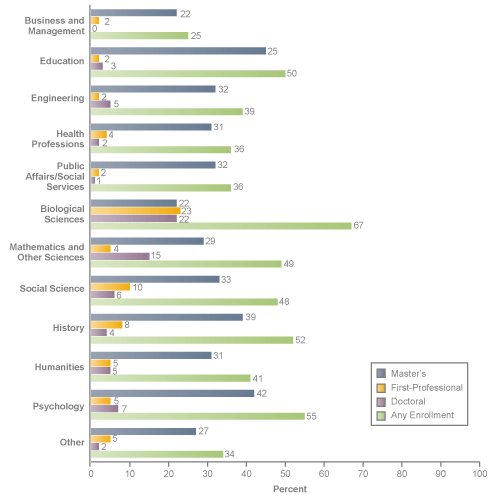

This indicator uses data from the 1992–93 Baccalaureate and Beyond Study (B&B:93/03), longitudinal study of students who earned a bachelor’s degree during the 1992–93 academic year. By 2003, a decade after completing a bachelor’s degree, 40 percent of 1992–93 graduates had enrolled in a graduate degree program (table 1). Table 1 looks at the highest graduate enrollment among 1992–93 bachelor’s degree recipients. Master’s degree programs were the most common, with 31 percent of bachelor’s degree recipients enrolled in them, compared with 5 percent in first-professional degree programs and 4 percent in doctoral degree programs.1 Looking specifically at graduates who enrolled in a master’s degree program, 7 percent enrolled in an MBA program (Master of Business Administration), 9 percent enrolled in an MEd program (Master of Education), and 14 percent enrolled in another type of master’s degree program.
Black graduates were more likely than White graduates to enroll in a graduate degree program (45 vs. 39 percent) (table 1). However, using data from the B&B:93/97 follow-up, McCormick et al. (1999) reported that among students who applied to a graduate degree program, Black graduates were admitted at a lower rate than Asian/Pacific Islander, Hispanic, and White graduates.2 Looking at enrollment in first-professional programs specifically, Asian/Pacific Islander graduates were more likely than graduates in other racial/ethnic groups to enroll within 10 years of earning a bachelor’s degree (14 vs. 5 percent).
The likelihood of enrolling in a graduate degree program was also related to age at bachelor’s degree completion. In general, younger graduates were more likely to enroll than older graduates. For example, 48 percent of graduates age 22 or younger at the time of bachelor’s degree completion enrolled in a graduate or first-professional degree program, compared with 36 percent of those age 30 or older. However, graduates age 30 or older when they completed a bachelor’s degree were just as likely to enroll in an MBA or MEd program as their peers age 22 or younger (MBA: 8 percent each and MEd 10 percent vs. 9 percent).
| Student and institution characteristics | Highest graduate enrollment | ||||||
|---|---|---|---|---|---|---|---|
| No enrollment | Total any enrollment | MBA | MEd | Other master's | First Professional | Doctoral | |
| Total | 60.0 | 40.0 | 7.3 | 8.8 | 14.4 | 5.0 | 4.5 |
| Race/ethnicity1 | |||||||
| White | 60.8 | 39.2 | 7.0 | 9.2 | 14.2 | 4.5 | 4.3 |
| Black | 54.6 | 45.4 | 8.3 | 7.5 | 19.1 | 5.3 | 5.2 |
| Hispanic | 56.3 | 43.7 | 9.4 | 9.7 | 13.9 | 4.7 | 6.1 |
| Asian/Pacific Islander | 58.5 | 41.5 | 8.3 | 3.3 | 12.7 | 13.6 | 3.7 |
| Age at bachelor's degree completion | |||||||
| 22 or younger | 51.8 | 48.3 | 7.8 | 9.4 | 16.9 | 7.7 | 6.5 |
| 23–24 | 67.9 | 32.1 | 5.8 | 8.2 | 11.2 | 3.3 | 3.6 |
| 25–29 | 72.8 | 27.2 | 6.5 | 5.8 | 11.5 | 2.0 | 1.6 |
| 30 or older | 63.8 | 36.2 | 8.2 | 9.9 | 14.6 | 1.9 | 1.6 |
| Bachelor's degree GPA | |||||||
| Under 2.5 | 76.5 | 23.5 | 4.4 | 6.3 | 9.9 | 1.6 | 1.3 |
| 2.5–2.99 | 64.4 | 35.6 | 7.3 | 8.3 | 13.8 | 3.3 | 3.0 |
| 3.0–3.49 | 56.6 | 43.4 | 7.6 | 9.7 | 15.0 | 6.2 | 4.9 |
| 3.5 or above | 47.8 | 52.2 | 9.0 | 10.1 | 17.7 | 7.5 | 7.8 |
| 1Black includes African American, Pacific Islander includes Native Hawaiian, and Hispanic includes Latino. Included in the totals but not shown separately are data for American Indian/Alaska Native respondents and those who identified themselves with another race not shown. Race categories exclude Hispanic origin unless specified. | |||||||
| NOTE: Estimates include students from the 50 states, DC, and Puerto Rico. Detail may not sum to totals because of rounding. Standard error tables are available on this page. | |||||||
| SOURCE: Table A in Nevill, S.C., and Chen, X. (2007). The Path Through Graduate School: A Longitudinal Examination 10 Years After Bachelor’s Degree (NCES 2007-162) |
|||||||
The cumulative GPAs of graduates were positively related to their rates of graduate enrollment. Higher achieving bachelor’s degree recipients were more likely to have enrolled in a graduate degree program by 2003 than their lower achieving counterparts (52 vs. 24 to 43 percent) (table 1).
The frequency of enrollment in a graduate or first-professional degree program was also related to undergraduate major. Graduates who had majored in business as undergraduates were less likely to enroll in a graduate degree program than graduates with other majors (25 vs. 34 to 67 percent), while graduates who had majored in biological sciences were more likely to enroll than graduates who had majored in other fields (67 vs. 25 to 55 percent) (figure 1). This was especially apparent among graduates who enrolled in a first-professional or doctoral degree program. Graduates who had majored in biological sciences as undergraduates were more likely to enroll in a first-professional or doctoral program than graduates who had majored in any other field (23 and 22 percent, respectively, vs. 2 to 10 percent and .5 to 15 percent, respectively). Furthermore, graduates who had majored in mathematics as undergraduates were generally more likely than graduates with other majors to enroll in a doctoral degree program (15 vs. .5 to 7 percent).
